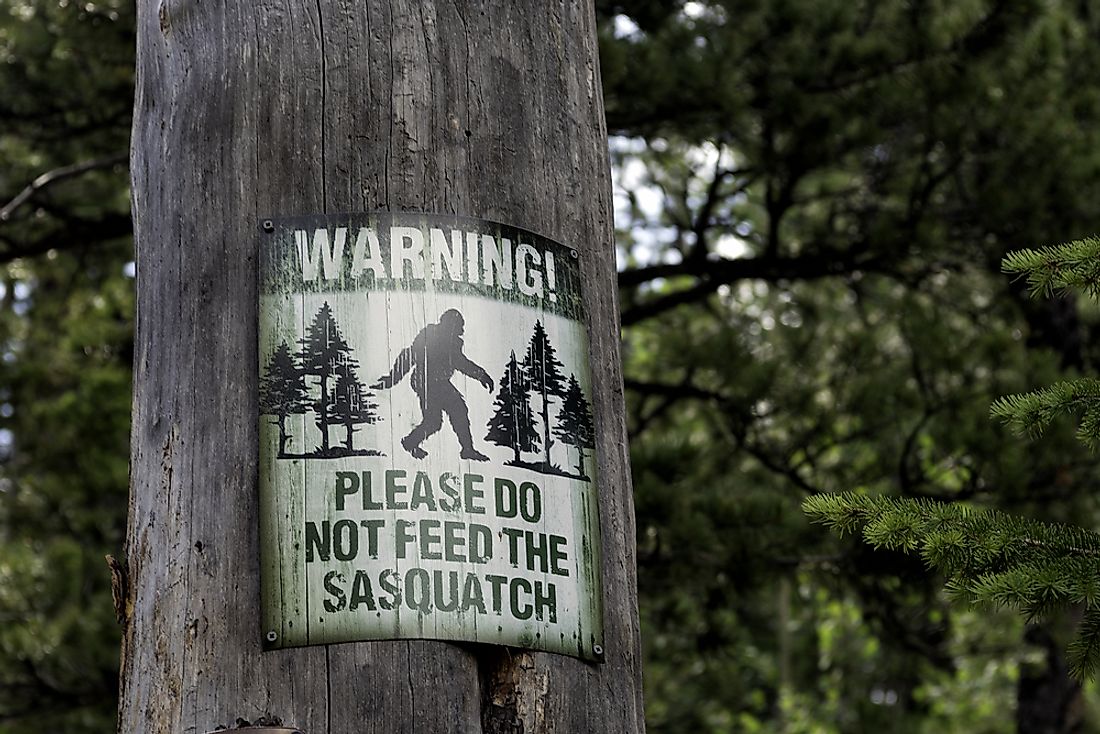Bigfoot and Other Tales of Forest Folklore

For centuries, Bigfoot tales have been shrouded in mystery. Sightings of Bigfoot have reportedly occurred but none have been proven. Searches for various Bigfoot creatures around the world has never been successful either. Hair samples, footprints, and videos have been documented over the years but Bigfoot creatures still remain in the realm of legend and cryptozoology. To some, Bigfoot stories are a mere hoax.
Interestingly, many countries around the world have their own version of Bigfoot. Some of the Bigfoot folklore from different countries are discussed below.
9. Bigfoot
Also known as the Sasquatch, Bigfoot is an ape-like creature, large, and covered in hair. It is said to live in American forests, especially in the Pacific Northwest. Bigfoot acquired its name from its enormous footprints claimed to be approximately 60cm long and 20cm wide. Bigfoot is believed to a Gigantopithecus, an ape from Asia believed to have gone extinct over 300,000 years ago. The Yeti and Yeren, both from Asia, are also thought to be of the Gigantopithecus origin. The American Bigfoot is one of the most documented and researched folklore. Bigfoot organizations have been set up to investigate Bigfoot credibility. Of such, the oldest organization is the Bigfoot Field Researchers Organization (BFRO).
8. Mogollon Monster
The Mogollon Monster is an ape-like creature believed to be about 7ft tall with black hair covering its body. Some Mogollon Monsters have also been reported to have reddish-brown hair. The Mogollon was reportedly sighted in Eastern Arizona, along the Mogollon Rim. It has also been allegedly spotted around Prescott and in the Grand Canyon. Several campers on the mountain that hosts the Mogollon Rim have reported several accounts of the monster raiding their sites in search for food.
7. Tsul 'Kalu
Tsul ‘Kalu is believed to be the Cherokee version of Bigfoot. Tsul ‘Kalu means “he has them sloping” purportedly used to refer to the creature’s eyes. This creature is supposedly able to control and read minds. Tsula’sinun’yi located on the Tuckasegee River in North Carolina, is a place said to be associated with this creature. The place is said to have had footprints of Tsul ‘Kalu before being destroyed during railroad building. Tsul ‘Kalu is also said to dwell in Tsunegun’yi on the slopes of Tanasee Bald mountain. Markings and scratching on a nearby slab of soapstone (Jatawalla Rock) are also said to be that of Tsul ‘Kalu.
6. Yeren
Also known as Yiren, Yeh Ren, or the Chinese Wildman, the Yeren monster is purportedly 6ft tall and covered in reddish brown hair. It is believed that Yeren lives in the mountains of China, with most sightings coming from the remote Hubei province.
5. Yeti
Yeti is a Bigfoot of Nepal. It is also referred to as the Abominable Snowman. Yeti is an ape-like creature said to inhabit the Himalayan region of Nepal, Bhutan, and Tibet. The search for Yeti has not been successful despite the various traces of hair and footprints found in Tibet.
4. Yowie
Yowie is an ape-like creature reputed to live in Australia. It is 6ft tall, hairy, and has an upright posture like that of humans. The Yowie has been reported to be violent and aggressive, although it is generally shy and timid. In Queensway, the creature is referred to as Quinkin or Joogabinna, while in parts of New South Wales it is known as Jurrawarra, Doolaga or Gulaga. The first sighting of Yowie has been reported to have taken place in 1795, and reports of Yowie sightings have continued to present day. Many have claimed attacks on their dogs by Yowie, although these claims are yet to be proved. In 2013, a resident of Lismore claimed to have seen a Yowie in Bexhill. Queensway has also recorded a number of cases where residents claim to have seen the Yowie.
3. Menk
Menk is a Russian Bigfoot named from the Mansi language. Mansi is an indigenous community living in Khanty-Mansi Autonomous Okrug, Russia. It is believed that Menk was first sighted in 1959 in the Ural Mountains. A group of students from the then Ural Polytechnic Institute had gone hiking the mountain. Their bodies were later found mutilated, allegedly by Menk.
2. Hibagon
Hibagon or Hinagon is a Japanese Bigfoot. It is said to be a black gorilla-like creature. It is 5ft tall, weighing about 180 pounds, and its body is covered with brown hair. Hibagon is believed to have a snub nose, and its face is covered in bristles. It reportedly has a foul smell and glaring eyes. Hibagon was reportedly first sighted in 1970 by a group of elementary school students who were out picking wild mushrooms in the forest of Mount Hiba. Since then, it has been seen on diverse times up to 1982. It is believed that Hibagon resides in Mt Hiba in Northern Hiroshima.
1. Grassman
Grassman is believed to hail from Ohio, hence the name the Ohio Grassman. It is also called Kenmore Grassman. It is an ape-like creature that reportedly inhabits the grasslands of Ohio, but its existence is yet to be proved. Grassman stands at 7ft tall and weighs 300 pounds. Its name was derived from the small hut-like structures it builds out of grass. It is believed to have been first sighted in 1978 in Minerva Village.











